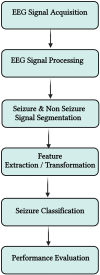Sustainable E-Health: Energy-Efficient Tiny AI for Epileptic Seizure Detection via EEG
- PMID: 40792199
- PMCID: PMC12336407
- DOI: 10.1177/11795972241283101
Sustainable E-Health: Energy-Efficient Tiny AI for Epileptic Seizure Detection via EEG
Abstract
Tiny Artificial Intelligence (Tiny AI) is transforming resource-constrained embedded systems, particularly in e-health applications, by introducing a shift in Tiny Machine Learning (TinyML) and its integration with the Internet of Things (IoT). Unlike conventional machine learning (ML), which demands substantial processing power, TinyML strategically delegates processing requirements to the cloud infrastructure, allowing lightweight models to run on embedded devices. This study aimed to (i) Develop a TinyML workflow that details the steps for model creation and deployment in resource-constrained environments and (ii) apply the workflow to e-health applications for the real-time detection of epileptic seizures using electroencephalography (EEG) data. The methodology employs a dataset of 4097 EEG recordings per patient, each 23.5 seconds long, from 500 patients, to develop a robust and resilient model. The model was deployed using TinyML on microcontrollers tailored to hardware with limited resources. TensorFlow Lite (TFLite) efficiently runs ML models on small devices, such wearables. Simulation outcomes demonstrated significant performance, particularly in predicting epileptic seizures, with the ExtraTrees Classifier achieving a notable 99.6% Area Under the Curve (AUC) on the validation set. Because of its superior performance, the ExtraTrees Classifier was selected as the preferred model. For the optimized TinyML model, the accuracy remained practically unchanged, whereas inference time was significantly reduced. Additionally, the converted model had a smaller size of 256 KB, approximately ten times smaller, making it suitable for microcontrollers with a capacity of no more than 1 MB. These findings highlight the potential of TinyML to significantly enhance healthcare applications by enabling real-time, energy-efficient decision-making directly on local devices. This is especially valuable in scenarios with limited computing resources or during emergencies, as it reduces latency, ensures privacy, and operates without reliance on cloud infrastructure. Moreover, by reducing the size of training datasets needed, TinyML helps lower overall costs and minimizes the risk of overfitting, making it an even more cost-effective and reliable solution for healthcare innovations.
Keywords: IoT; TinyML; e-health; electroencephalography; embedded systems; epileptic seizure; machine learning.
© The Author(s) 2025.
Conflict of interest statement
The author(s) declared no potential conflicts of interest with respect to the research, authorship, and/or publication of this article.
Figures










Similar articles
-
Optimising TinyML with quantization and distillation of transformer and mamba models for indoor localisation on edge devices.Sci Rep. 2025 Mar 24;15(1):10081. doi: 10.1038/s41598-025-94205-9. Sci Rep. 2025. PMID: 40128553 Free PMC article.
-
Comparison of Two Modern Survival Prediction Tools, SORG-MLA and METSSS, in Patients With Symptomatic Long-bone Metastases Who Underwent Local Treatment With Surgery Followed by Radiotherapy and With Radiotherapy Alone.Clin Orthop Relat Res. 2024 Dec 1;482(12):2193-2208. doi: 10.1097/CORR.0000000000003185. Epub 2024 Jul 23. Clin Orthop Relat Res. 2024. PMID: 39051924
-
Intravenous magnesium sulphate and sotalol for prevention of atrial fibrillation after coronary artery bypass surgery: a systematic review and economic evaluation.Health Technol Assess. 2008 Jun;12(28):iii-iv, ix-95. doi: 10.3310/hta12280. Health Technol Assess. 2008. PMID: 18547499
-
Idiopathic (Genetic) Generalized Epilepsy.2024 Feb 12. In: StatPearls [Internet]. Treasure Island (FL): StatPearls Publishing; 2025 Jan–. 2024 Feb 12. In: StatPearls [Internet]. Treasure Island (FL): StatPearls Publishing; 2025 Jan–. PMID: 31536218 Free Books & Documents.
-
A rapid and systematic review of the clinical effectiveness and cost-effectiveness of paclitaxel, docetaxel, gemcitabine and vinorelbine in non-small-cell lung cancer.Health Technol Assess. 2001;5(32):1-195. doi: 10.3310/hta5320. Health Technol Assess. 2001. PMID: 12065068
References
-
- World Health Organization. Fact sheet on epilepsy. https://www.who.int/news-room/fact-sheets/detail/epilepsy
-
- Scarpato N, Pieroni A, Di Nunzio L, et al. E-health-IoT Universe: a review. Int J Adv Sci Eng Inform Technol. 2017;7:2328-2336.
-
- King MA, Newton MR, Jackson GD, et al. Epileptology of the first-seizure presentation: a clinical, electroencephalographic, and magnetic resonance imaging study of 300 consecutive patients. Lancet. 1998;352:1007-1011. - PubMed
-
- Sierra Marcos A, Toledo M, Quintana M, et al. Diagnosis of epileptic syndrome after a new onset seizure and its correlation at long-term follow-up: longitudinal study of 131 patients from the emergency room. Epilepsy Res. 2011;97:30-36. - PubMed
LinkOut - more resources
Full Text Sources
Miscellaneous

